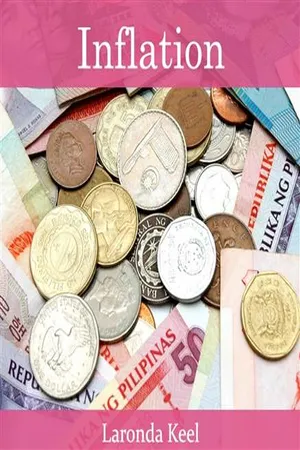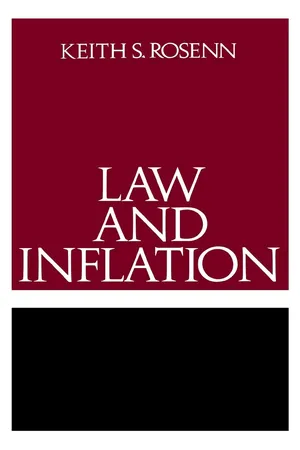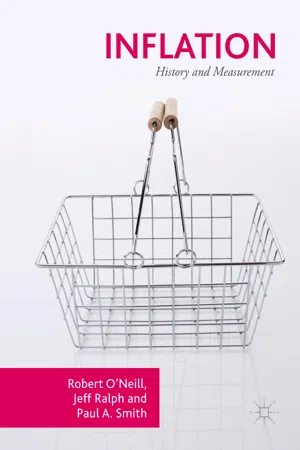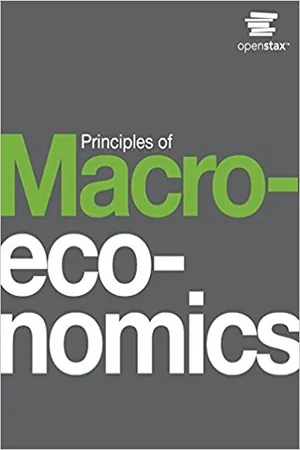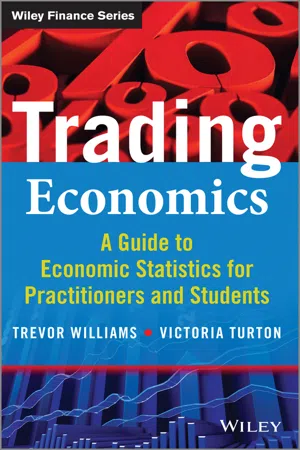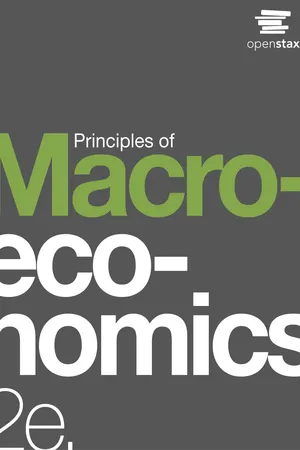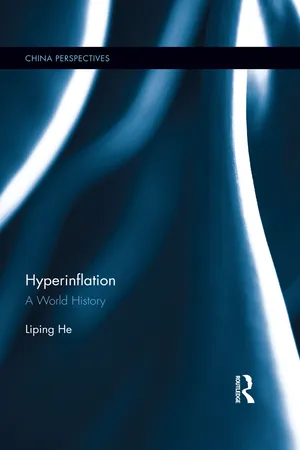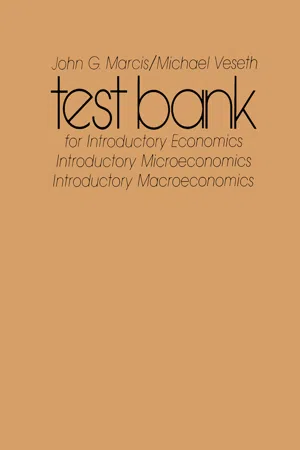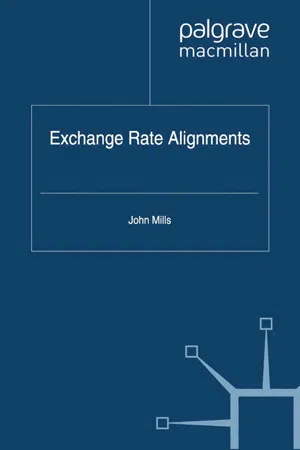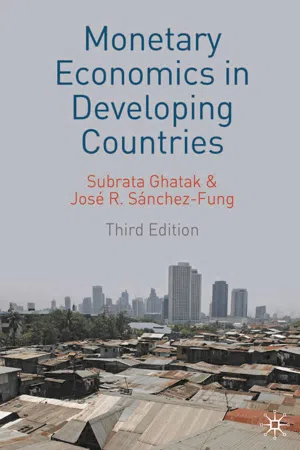Economics
Inflation
Inflation refers to the general increase in prices of goods and services in an economy over a period of time. It is typically measured as an annual percentage increase in the Consumer Price Index (CPI). Inflation erodes the purchasing power of money, leading to a decrease in the value of a currency and impacting consumers, businesses, and the overall economy.
Written by Perlego with AI-assistance
Related key terms
1 of 5
10 Key excerpts on "Inflation"
- No longer available |Learn more
- (Author)
- 2014(Publication Date)
- Orange Apple(Publisher)
____________________ WORLD TECHNOLOGIES ____________________ Chapter- 1 Inflation In economics, Inflation is a rise in the general level of prices of goods and services in an economy over a period of time. When the general price level rises, each unit of currency buys fewer goods and services. Consequently, Inflation also reflects an erosion in the purchasing power of money – a loss of real value in the internal medium of exchange and unit of account in the economy. A chief measure of price Inflation is the Inflation rate, the annualized percentage change in a general price index (normally the Consumer Price Index) over time. Inflation's effects on an economy are various and can be simultaneously positive and negative. Negative effects of Inflation include a decrease in the real value of money and other monetary items over time, uncertainty over future Inflation may discourage investment and savings, and high Inflation may lead to shortages of goods if consumers begin hoarding out of concern that prices will increase in the future. Positive effects include ensuring central banks can adjust nominal interest rates (intended to mitigate recessions), and encouraging investment in non-monetary capital projects. Economists generally agree that high rates of Inflation and hyperInflation are caused by an excessive growth of the money supply. Views on which factors determine low to moderate rates of Inflation are more varied. Low or moderate Inflation may be attributed to fluctuations in real demand for goods and services, or changes in available supplies such as during scarcities, as well as to growth in the money supply. However, the consensus view is that a long sustained period of Inflation is caused by money supply growing faster than the rate of economic growth. Today, most mainstream economists favor a low steady rate of Inflation. - eBook - PDF
- Keith S. Rosenn(Author)
- 2015(Publication Date)
- University of Pennsylvania Press(Publisher)
Inflation'S CAUSES AND CURES The term Inflation is often used loosely in English to mean anything from pomposity to increases in money, income, and profits. 1 For the pur-poses of this book, Inflation is used to refer either to a sustained rise in an economy's general level of prices or to a corresponding fall in the domestic purchasing power of an economy's currency. This working definition im-plies that Inflation is a dynamic process in which the aggregate level of prices is moving upward over time while the purchasing power of money is in corresponding decline. It does not mean that all prices are moving upward uniformly, nor even that all prices are moving upward. It does mean that an economy is undergoing Inflation when it presently costs more to purchase a representative sample of goods than it cost in the past. Inflation and its opposite, deflation, describe changes in a nation's internal price levels or its currency's domestic purchasing power. Changes in a currency's external purchasing power occur through adjust-ments in the foreign exchange rate. When the value of country A's cur-rency declines relative to the currency of country B, there has been a devaluation of country A's currency. Correspondingly, there has been an upward revaluation in country B's currency relative to country A. In com-mon parlance references to changes in internal and external purchasing power of a currency are frequently commingled; it is not uncommon to find courts confusingly referring to devaluation when they really mean depreciation in domestic purchasing power. 2 In the long run, countries experiencing Inflation rates higher than those of customary trading part-ners will be forced to devalue; however, in the short run, it is frequently possible for countries to maintain the same exchange rate despite sub-stantial domestic Inflation, or to devalue by less than the Inflation rate differential. - eBook - PDF
Inflation
History and Measurement
- Robert O'Neill, Jeff Ralph, Paul A. Smith(Authors)
- 2017(Publication Date)
- Palgrave Macmillan(Publisher)
For many people, a definition of Inflation as the increase in the price levels experienced in an economy may be enough for them to be happy that they understand it. However, for those of a statistical mindset, the 1 We note here that we are deliberately keeping away from the contentious phrase ‘maintaining a fixed standard of living’, which will be discussed more fully in later chapters. 2 See, for example, Mankiw and Taylor (2017), p. 583 or Sloman et al., p. 262. 2 What Is Inflation? 23 definition of Inflation we have offered is likely to call to mind questions regarding what the price level experienced by people in an economy is and how we go about measuring it when we are in a situation in which we do not have complete information regarding prices and quantities involved in economic transactions. It is, however, worth noting that the rest of this book is focused on how changes in price levels are measured by statisticians and how they relate to the original concept of Inflation which we often see defined at a fairly high level. If these questions did not come to mind when you read or heard the definition of Inflation mentioned above then it is hoped that this book will help you see that they are important for understanding the phenomenon of Inflation and its measurement. If you immediately questioned how the price level might be measured, we hope this book will provide at least a partial solution to the questions you are asking. Alongside the definition of Inflation, we will also often hear econo- mists make use of the term deflation which the OED defines as a reduc- tion in the level of prices in an economy. 3 This refers to periods of time in which the level of prices, however measured, is declining, rather than increasing as is the more common situation in modern economies. - eBook - PDF
- Steven A. Greenlaw, Timothy Taylor(Authors)
- 2014(Publication Date)
- Openstax(Publisher)
Inflation, on the other hand, means that there is pressure for prices to rise in most markets in the economy. In addition, price increases in the supply-and-demand model were one-time events, representing a shift from a previous equilibrium to a new one. Inflation implies an ongoing rise in prices. If Inflation happened for one year and then stopped—well, then it would not be Inflation any more. This chapter begins by showing how to combine prices of individual goods and services to create a measure of overall Inflation. It discusses the historical and recent experience of Inflation, both in the United States and in other countries around the world. Other chapters have sometimes included a note under an exhibit or a parenthetical reminder in the text saying that the numbers have been adjusted for Inflation. In this chapter, it is time to show how to use Inflation statistics to adjust other economic variables, so that you can tell how much of, say, the rise in GDP over different periods of time can be attributed to an actual increase in the production of goods and services and how much should be attributed to the fact that prices for most things have risen. Inflation has consequences for people and firms throughout the economy, in their roles as lenders and borrowers, wage-earners, taxpayers, and consumers. The chapter concludes with a discussion of some imperfections and biases in the Inflation statistics, and a preview of policies for fighting Inflation that will be discussed in other chapters. 9.1 | Tracking Inflation By the end of this section, you will be able to: • Calculate the annual rate of Inflation • Explain and use index numbers and base years when simplifying the total quantity spent over a year for products • Calculate Inflation rates using index numbers Dinner table conversations where you might have heard about Inflation usually entail reminiscing about when “everything seemed to cost so much less. - eBook - PDF
Trading Economics
A Guide to Economic Statistics for Practitioners and Students
- Trevor Williams, Victoria Turton(Authors)
- 2014(Publication Date)
- Wiley(Publisher)
4 Inflation Inflation is always and everywhere a monetary phenomenon in the sense that it is and can be produced only by a more rapid increase in the quantity of money than in output. Milton Friedman 1 WHAT IS Inflation? Inflation tells us the changing (increasing) price of a range of goods or services; basically how much of something we can get for our money. The rate of change of prices – the speed at which the price of goods and services that are bought by households or businesses alter – is called Inflation. But prices can also fall, in a process called deflation, sometimes termed negative Inflation. Inflation is more common than deflation, or at least it has been in the last 50 years or so, and so it has become associated with changes in the price of goods and services. Historically, however, price falls were as common as price rises, as we will see later. Both Inflation and deflation have advantages and disadvantages, which we will explore in more detail later in this chapter. THE HISTORY OF Inflation Inflation has been around for a long time, but, as Figure 4.1 shows, the level of prices (the index) really only rose consistently and sharply in the UK from the 1970s onwards. This was after the US came off the gold standards and the Bretton Woods system of fixed exchange rates, which had prevailed after the Second World War, ended. Money was now backed by government fiat and trust rather than by gold. And exchange rates were no longer fixed but allowed to float freely. This seems to have led to a rapid rise in the level of prices or, in other words, to the Retail Prices Index. Before that, for hundreds of years, the level 1 Friedman, M., The Counter-Revolution in Monetary Theory (1970). 100 Trading Economics Retail Price Index (1987 = 100) 0 10 20 30 40 50 60 70 80 90 100 1264 1296 1328 1360 1392 1424 1456 1488 1520 1552 1584 1616 1648 1680 1712 1744 1776 1808 1840 1872 1904 1936 1968 2000 Figure 4.1 Price index over time. - eBook - PDF
- Steven A. Greenlaw, Timothy Taylor, David Shapiro(Authors)
- 2017(Publication Date)
- Openstax(Publisher)
A relative price change occurs when you see that the price of tuition has risen, but the price of laptops has fallen. Inflation, on the other hand, means that there is pressure for prices to rise in most markets in the economy. In addition, price increases in the supply-and-demand model were one-time events, representing a shift from a previous equilibrium to a new one. Inflation implies an ongoing rise in prices. If Inflation happened for one year and then stopped, then it would not be Inflation any more. This chapter begins by showing how to combine prices of individual goods and services to create a measure of overall Inflation. It discusses the historical and recent experience of Inflation, both in the United States and in other countries around the world. Other chapters have sometimes included a note under an exhibit or a parenthetical reminder in the text saying that the numbers have been adjusted for Inflation. In this chapter, it is time to show how to use Inflation statistics to adjust other economic variables, so that you can tell how much of, for example, we can attribute the rise in GDP over different periods of time to an actual increase in the production of goods and services and how much we should attribute to the fact that prices for most items have risen. Inflation has consequences for people and firms throughout the economy, in their roles as lenders and borrowers, wage-earners, taxpayers, and consumers. The chapter concludes with a discussion of some imperfections and biases in the Inflation statistics, and a preview of policies for fighting Inflation that we will discuss in other chapters. - eBook - PDF
- He Liping(Author)
- 2017(Publication Date)
- Routledge(Publisher)
Modern periods of Inflation have been closely related to these factors. When infla-tion occurs in a country over a period of time, people can often identify at least one of the five factors. Clearly, though, these factors are not sufficient conditions for Inflation, not to mention hyperInflation. In a paper currency system, for instance, deflation can occur as much as Inflation. In the 2010s, many governments around the world run budget deficits, yet their national economies barely see any signifi-cant Inflation. For hyperInflation to arise, something else must be in effect. Often before a period of hyperInflation, an economy has already experienced substantial Inflation, which the government has already attempted to contain through certain policy measures. HyperInflation very rarely occurs all of a sudden, without any early warning signs. Rather, hyperInflation usually results from previous Inflation that has eventually escalated to an astronomical level. Therefore, hyperInflation has its own causes, distinctively different from those of “ordinary” Inflation, the following three of which are the most relevant: • Policy failure in an Inflation stabilization process; • Institutional deficiency that causes the public to lose trust in the government and confidence in a stabilization process; and • International isolation. 6 Introduction Understanding these three points requires a little knowledge of the framework of modern finance, in which governments play the role of money creator. Milton Friedman’s popular statement that “substantial Inflation is always and everywhere a monetary phenomenon” 8 captures the essence of the quantity theory of money, which says the relation between money supply and price level in an economy at any point in time is constant under given economic conditions. In plain words, this relation implies that price Inflation cannot rise beyond the maximum level the money supply could possibly accommodate. - eBook - PDF
Test Bank for Introductory Economics
And Introductory Macroeconomics and Introductory Microeconomics
- John G. Marcis, Michael Veseth(Authors)
- 2014(Publication Date)
- Academic Press(Publisher)
e. economic statistic which describes how real income is related to nominal income. 50. Inflation is generally defined as: (80) a. a decrease in the general level of prices. b. an increase in the prices of selected items. C. an increase in the general level of prices. d. a decrease in the prices of selected items. e. a program which ties wages, values and/or taxes to a price index. 51. Consumers paid $125 for a particular basket of goods and services in 1980 and paid $ 150 for the same basket in 1981. What was the annual rate of Inflation between 1980 and 19817(92-94) a. Approximately 17 percent. B. Approximately 20 percent. c. Not enough information has been provided. d. Approximately 117 percent. e. Approximately 120 percent. 52. Consumers paid $34.50 for a particular basket of goods and services in 1970 and paid $52.90 for the same basket in 1977. What was the annual rate of Inflation between 1970 and 19777(92-94, Tab. 4-2) A. Approximately 53 percent. b. Approximately 67 percent. c. Not enough information has been provided. d. Approximately 47 percent. e. Approximately 33 percent. 53. Consumers paid $100 for a particular basket of goods and services in 1979 and paid $ 150 for a different basket of goods and services in 1981. What was the annual rate of Inflation between 1979 and 19817(92-94) a. Approximately 50 percent. b. Approximately 33 percent. C. Not enough information has been provided. d. Approximately 67 percent. e. Approximately 100 percent. 54. According to Veseth, a price index: (81) a. is a book which firms use to determine prices. B. is an approximate measure of the cost of a fixed market basket of goods relative to the same basket in a base period. c. cannot be computed for an economy because the total number of goods in the economy is so large. d. is an approximate measure of the cost of a market basket of goods relative to another basket of goods in a base period. - eBook - PDF
- J. Mills(Author)
- 2012(Publication Date)
- Palgrave Macmillan(Publisher)
3 The widely exhibited determination in the Western world to keep Inflation down to very low levels is not, therefore, a sign of economic wisdom. It is much more convincingly seen as another sign of the 3 Inflation Inflation 41 dominance in the West of the culture and outlook of banking and finance over manufacturing and industry. Low Inflation – and the high real interest rates which go with it – favours old money vis-à-vis new; lenders as against borrowers; established wealth holders as opposed to parvenus; and the already successful vis-à-vis their challengers. All these powerful groups, typically with deeply conservative instincts, have a vested interest in treating Inflation as a major affliction. In fact, in moderation – at 4 to 5 per cent, to allow something of a safety margin against shocks which might push it up to more dangerous levels – it is nothing of the kind. On the contrary, it is an almost entirely unavoid- able but relatively harmless concomitant to any policies seriously orien- tated towards accelerating the growth rate and getting everyone back to work. A particularly strong link in the chain of Inflationary demonology has been firmly established in the public mind – and in the academic and policy-orientated literature – in relation to any downward change in the exchange rate. Fear that devaluations automatically generate Inflationary pressures in economies where they occur is widespread. A long-standing major tenet of the monetarist position is that any bene- fits secured from depreciation will at best be temporary. Price rises in the devaluing country will soon wipe them out, it is argued, and the economy concerned, after a short adjustment process, will be left no more competitive than it was before, save that it will have added an enhanced level of Inflation. It is also widely believed that a devaluation necessarily produces a reduction in the living standards of an economy whose currency’s external value is falling. - eBook - PDF
- Subrata Ghatak, José R. Sánchez-Fung(Authors)
- 2017(Publication Date)
- Red Globe Press(Publisher)
The overall conclusion that might be suggested is that there are a number of reasons for expecting that Inflation much in excess of 10 per cent per annum is likely to have an adverse effect on the long-run development of a country, since any positive impact on total investment can easily be outweighed by adverse effects on the composition of investment, the degree of monetization and the efficiency of the financial system. In the long run, growth and development may best be promoted by having a target rate of Inflation of zero, while erring on the side of Inflation rather than deflation. 9.3.1 Further empirical evidence on inflation and growth The evidence explained so far in this chapter assumes implicitly that there is a linear relationship between money and growth, and there is somewhat firm evidence that high Inflation is bad for growth (see, for example, De Gregorio, 1992; Barro, 1995). However, an influential paper by Levine and Zervos (1993) revealed that Inflation’s effect on output does not pass Leamer’s extreme bounds tests in growth regressions (see also Sala-i-Martin, 1997). That is, Inflation is not associated robustly with economic growth in a statistical sense. Also, Bruno and Easterly (1998) showed that, after excluding countries with Inflation rates above 40 per cent from growth regressions, Inflation’s statistical significance diminishes. And other authors, such as Temple (2000), are rather sceptical about the literature examining the link between Inflation and growth. Still, ongoing research efforts are making progress in improving our understanding of the critical relationship between Inflation and growth. In particular, modelling the relationship among these variables has recently considered the relevance of looking at non-linear and threshold effects. That is, whether or not there is a certain level (threshold) of Inflation beyond which it matters more, say, than at lower levels (non-linearity), in determining economic growth.
Index pages curate the most relevant extracts from our library of academic textbooks. They’ve been created using an in-house natural language model (NLM), each adding context and meaning to key research topics.
